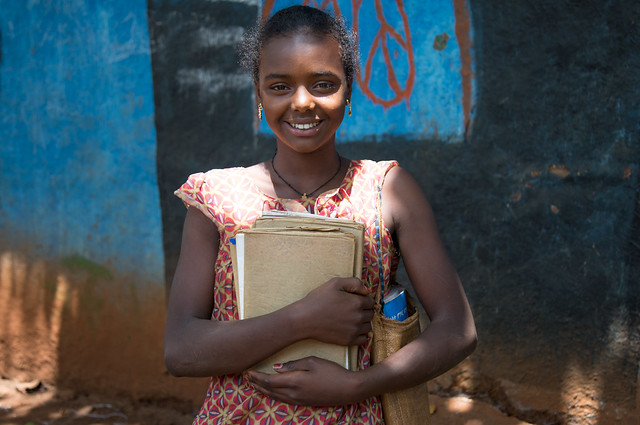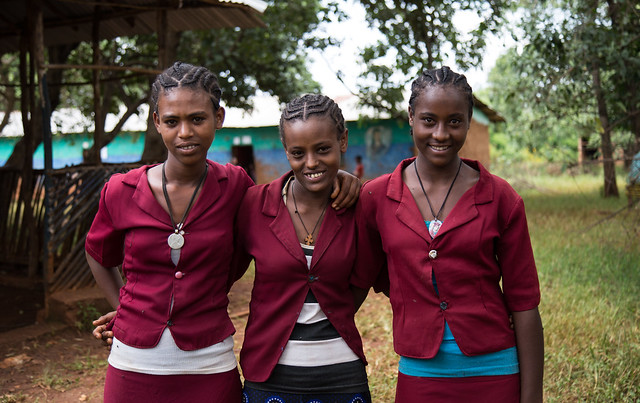By Dorosella Bishanga
ITANG SPECIAL WOREDA (DISTRICT), GAMBELLA REGIONAL STATE, 6 October 2017-While it is commonly understood that water flowing in river streams is not clean and suitable for drinking nor cooking, in Itang town, Baro River was the only main source of water supply in which households depended for everyday domestic use. Consequently, as the Itang Town Water Supply Scheme was launched in October 2017, residents were delighted for the assured access to clean and reliable water supply.
The inauguration event of the Itang Town Water Supply Scheme was attended by his Excellency Senai Akwer, Vice President, Gambella Regional State, his Excellency, Thok Thoan, Head, Gambella Regional Bureau of Water and Resource Development. Ms Gillian Mellsop, UNICEF Representative to Ethiopia, Ms Ginevra Letizia, Head of the Italian Cooperation Agency Office, members of the Woreda Administration, the residents of Itang town, and delegations from UNICEF and the Italian Agency for Development Cooperation in Ethiopia.

During the inauguration of the Itang Water Supply Scheme, UNICEF Representative, Gillian Mellsop expressed her gratitude both to the Gambella Regional and the Itang Special Woreda leaders, by recognizing their commitment during the implementation of the Itang Water Supply Scheme and the remarkable collaboration towards realizing key development milestones on access to clean water as put forward in the government development agenda. Ms. Mellsop said, “With the right investment, it is possible to provide a more reliable and resilient water service to rural communities; that reduces their vulnerability and also improves the quality of their lives – in this case, also contribute to peace building efforts by avoiding potential conflict over limited available resources.”
Conveying her gratitude for the financial contributions made by the Italian Agency for Development Cooperation, which made it possible for the building of the Itang Town Water Scheme, Ms Mellsop added, “I also thank our very generous donors, including the Italian Cooperation Agency, who are also here with us, whose support has made it possible for the building of the permanent water scheme that not only provides water for the town but also the large population of refugees that is hosted in three refugee camps Tierkidi, Kule and Nguenyiel found in this Woreda.”
Likewise, Ms Ginevra Letizia, the Director of the Italian Agency for Development Cooperation (AICS) conveyed her gratefulness to the Regional and Itang Woreda administration for their cooperation as well as the management to ensure the successful completion of the project. Insisting on the need to strengthen community structures hosting refugees, Ms Letizia said, “It is a pillar for the AICS humanitarian interventions to also target hosting communities since these are the ones sustaining the burden of welcoming refugees and an equitable access for both to basic services like water is a guarantee for peace and stability.”

The Itang water supply scheme will provide water for 11,319 and 10,000 individuals in Itang and Thurpham respectively. As part of the multi donor integrated water supply project, the project will provide safe water to a total of 205,703 refugees in three camps of Kule, Tierkidi and Nguenyiel refugee camps after the system upgrade.
To curtail the development – humanitarian funding challenges, UNICEF is responding to humanitarian needs in emergency contexts, while at the same time investing in government management systems to increase the self-reliant capacity of the communities. Being one of the emerging regional states and emergency affected regions in the country hosting a proportionally large population of refugees compared to the hosting population, UNICEF has prioritized Gambella. UNICEF provides support to increase sustainable community access to safe water supply by funding the construction, rehabilitation and maintenance of water supply schemes both in refugee camps and host communities.
Besides, UNICEF is adopting new approaches to provide water to communities where water is scarce by conveying water from reliable ground water sources where it is available. Shifting from surface water sources to groundwater sources, the Itang Town Water Supply Scheme is composed of pressure main line collector pipes, storage tanks/reservoirs, a central collection tank, a booster station and an elevated water tank. In addition, the system includes the installation of electro-mechanical equipment such as pumps and generators to the host communities in Itang. 18 water kiosks including the pipe distribution system have been constructed to supply at least 20 litres of water for daily use by communities.
To ensure optimum water use, the Itang Town Water Supply System is being upgraded with the aim to meet the demand of an additional 85,000 refugees in the newly established Nguenyiel camp and surrounding communities. Through collaboration and additional financial support from the German / KfW funding, the project will supply and install pressure main pipes from Itang to the booster station, install additional storage tanks at the collection chamber and booster station, construct additional power houses, supply and install additional electro-mechanical equipment at Itang and the Thurpham pumping station, drill two additional boreholes and rehabilitate two additional boreholes.
Similarly, UNICEF has led the development of the business plan for the entire water supply project by promoting cost recovery through user fees obtained for domestic uses of water for drinking, food preparation, washing, cleaning and miscellaneous domestic purposes and institutional uses. A study was conducted with residents of Itang and Thurpham analyzing the institutional capacity and willingness to pay for water supply and sanitation services. In the context of (i) what is being paid for water at the moment; (ii) consumers’ perception about the value of the effort they make to collect water; (iii) the maximum amount that consumers would be willing to pay for a water supply service and (iv) the affordable rate to be paid by the low-income section of the society to determine the bottom level of price for water.
Additionally, UNICEF is building the capacity of the Regional Water Bureau and Itang Special Woreda Water Office to improve the overall WASH sector coordination and institutional capacity building. UNICEF has supported the establishment of Itang Town Water Utility which will manage, operate and maintain the entire water supply project. In coordination with UNHCR and the Administration for Refugee and Returnee Affairs (ARRA), the government agency with the mandate for water supply provision for refugees in the country, UNICEF is implementing the cost recovery model of public sector utility management for WASH services as a sustainable long-term solution to service provision to refugee populations. As part of this model ARRA plays a key role through membership on the water board which oversees the water utility to ensure accountability to refugee populations.
As UNICEF continues to advocate for a robust partnership with the Regional Government and donor support for different programmes in the region; it calls for a well-defined operation and maintenance system to improve efficiencies, reduce water losses, and increase the sustainability of services.























